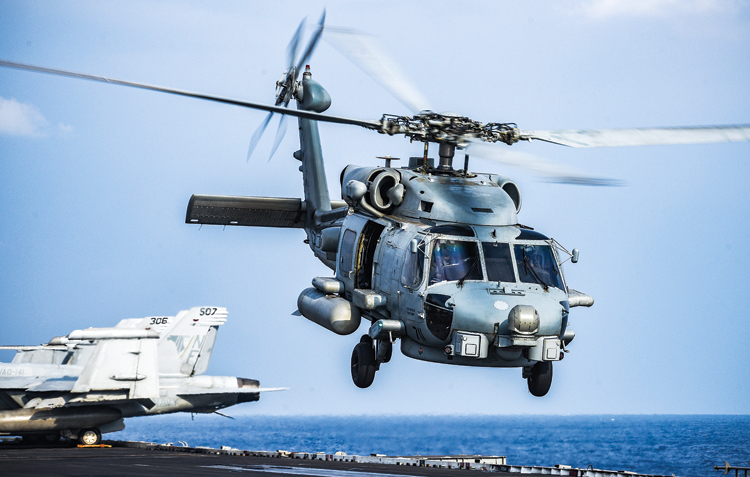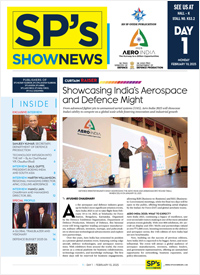- Prime Minister Narendra Modi inaugurates Aero India 2023 in Bengaluru; Releases Commemorative Stamp
- Defence Secretary meets delegations from Saudi Arabia, USA and Oman on the sidelines of Aero India 2023
- Foreign Ministers of 32 countries to attend Aero India 2023
- Embraer showcases the C-390 Millennium at Aero India 2023
Return of the Kings – The Multirole Helicopter Story

Exactly twenty years ago I solemnly gifted a memento to my ship on behalf of the Officers of my department. The memento was a solid 3 x 1.5 feet carved wooden frame, that surrounded two beautifully painted war elephants. We had carefully selected the two elephants from a stack of elephant paintings the best Rajasthani art dealer on Colaba Causeway had in his stock. Their eyes had to be ferocious and their tusks had to be razor sharp. That is because they were going to represent the best multirole helicopters (MRH) the world had seen then, the Sea King Mark 42Bs, known lovingly as just 42Bs, or Bravos. They were called Flying Frigates. Rightly so, as they could do almost anything the Frigate that carried them could do. With two Bravos each on ship, the Godavari Class were matchless fighting entities.
The occasion was the formal disbanding of the last Bravo Flight on the Godavari class Frigates. The reason was straightforward. In response to India’s bold step at Pokharan in 1998, the US had imposed sanctions and this was likely to affect the operational availability of the 42Bs. Though the Bravos had come to us at that time from UK’s Westland Helicopters Ltd (now Leonardo Helicopters), the basic aircraft was under the license of Sikorsky (a Lockheed Martin company), USA. So, till we could get a clearer picture on the effect of the US sanctions, the Indian Navy was prudently consolidating its assets as per a revised utilisation plan. My crew and I got posted out immediately thereafter.
When the 42Bs arrived in India between 1988 and 1990, they were the second lot of Sea Kings to ever come to India. The first lot of 12 had come in 1970, just before the Indo-Pak war. Equipped with an excellent Sonar and a Radar, they were the most modern ASW helicopters in the world when they arrived. But they came a bit too late and during the 1971 war, could only undertake some shore based operations from Mumbai. But soon after that, the Indian Navy managed to operate these large helicopters from Frigates and even acquired three more helicopters, with slight design changes to better suit operations from small decks. Getting these 10 tonne helicopters to operate from Frigates, was a path breaking innovation.
In the decade after the 1971 war, the Indian Navy carefully charted out options for all round up-gradation of military equipment, and some, much required indigenisation. In the field of multirole helicopters, it was to be a two pronged approach. For indigenisation, HAL was to first make a smaller MRH to develop skills and confidence. A larger one could follow later. Meanwhile, to meet operational needs, some MRH were to be imported. The choice fell again on Sea Kings, as they were still the best available.
But this time around, there was a difference. The aircraft was to be equipped with state of the art Weapons, Sensors, Communication systems, Navigation systems and most importantly, a Tactical Mission System (TMS) to integrate everything so that operating them was humanly possible. The mix was eclectic. Air to Surface Missiles (British Sea Eagle), Torpedoes (Italian A244S), Depth Charge Mk 11 (Indian), Radar (British), Dunking Sonar (French), ESM (Italian), Sonobuoy System (British), Tactical Air Navigation System (British), V/UHF (USA), VHF Homing (UK) & HF (USA) and a British TMS. This was the first time anyone was attempting to integrate this stupendous mix of capabilities into one helicopter. The best part was that this entire architecture was designed by India, to be executed by Westland Helicopters (now Leonardo Helicopters). This complex integration effort was the aviation equivalent of the amazing integration of multi country origin equipment the Indian Navy had achieved with the Godavari Class.
Only those who operated the 42Bs in their prime would know the extreme invincibility we felt. It won’t be too wrong to say that with half a dozen of them flying, the Arabian Sea had shrunk to a pond. Suddenly submarines in the region had a potent enemy and ships of adversaries couldn’t be sure of their safety from incoming missiles. Those making electronic transmissions could be identified and Over The Horizon Targeting as well as long range communications capabilities became virtual game changers. After a decade of this glory, the US sanctions hit. But the Bravos continued to operate. They still do.
It is ironic that the country which attempted to limit our operational capabilities through sanctions, is now poised to send us the third wave of the kings of the sea, the MRH. Earlier this year, India signed a multi billion $ deal with USA for 24 MH-60R helicopters from the Sikorsky (a Lockheed Martin company) family. They are expected to be delivered next year.
Yet again, the Arabian Sea is poised to shrink to a pond, as the MH-60R are the best MRH in the world today. Since they come from a family of helicopters with which the Indian Navy has a familiarity of over 50 years, in their operation and maintenance, we will hit the deck running too.
What does this reveal about India? Someone somewhere had kept steadily chipping away at shaping forei gn policy, ultimately achieving a reversal of relationship unimaginable two decades ago. The arrival of the second set of MRH in the end of the 1980s had been two decades after the arrival of the first batch in 1970. Two decades is the legitimate time period after which such aircraft should be replaced. The third set should have come by 2010. But the complex wheels of geopolitics and global economics delayed this arrival by ten years. India had steadily got stronger too during the period. It was only natural that suitors would flock, attracted by the value of our friendship and money.
Soon after I presented the memento of two painted elephants to my ship, I moved to New Delhi. One day, at the Aviation Directorate, I took a fresh, blue coloured official file cover and wrote MRH on it with a black marker pen. Little did I know at that time, that it will take 20 years for the English I started filling into the file, to manifest as real helicopter. I am glad that the day is almost here. A most critical operational gap is about to be closed. Indian Naval aviation is poised to soar higher.





